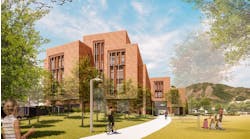News release from The University of Colorado: The Jennie Smoly Caruthers Biotechnology Building on the University of Colorado Boulder campus has received a LEED platinum rating from the U.S. Green Building Council.
The 336,800-square-foot research and teaching facility opened in April on the university’s east campus. More than 60 faculty and 500 researchers, staff and students from multiple disciplines work there on issues ranging from from cancer and heart disease to the development of new biofuels.
"Earning a LEED platinum rating for such a large research building highlights the engineering challenges of providing safe and practical research space while ensuring the highest level of sustainability," says Moe Tabrizi, director of campus sustainability.
A total of 975,000 bricks were used on the exterior of the building, as were 10,000 pieces of cut limestone. Forty-four miles of piping run throughout the building, which has four wings, and 3,400 pieces of glass were used during window construction. The building’s labs are modular and can be changed to accommodate the evolving needs of scientists and students.
The design of the building creates “research neighborhoods” made up of efficient and flexible research laboratories and areas for associated laboratory support. A “main street” corridor through the facility is intended to help foster interaction and collaboration.
The facility also is expected to stimulate job growth in the state's biotechnology industry. The building will increase collaboration among the three units sharing the new facility -- the Department of Chemical and Biological Engineering, the Division of Biochemistry and the University of Colorado Biofrontiers Institute.
The facility is 30 percent more energy- and water-efficient than recently constructed buildings with a similar function. The design situates labs with similar functions near each other in the building to centralize common lab equipment and maximize the efficiency of energy use, ventilation and heat recovery. The building’s mechanical and electrical systems incorporate significant energy savings and resource recovery.
The facility will have an array of large-scale, ground-mounted solar panels to help fulfill its energy needs. It also features evaporative cooling, which is the most energy-efficient cooling method in Colorado’s dry climate; daylight harvesting, lighting controls and LED technology; energy-efficient freezer compressors and lab exhaust fume hoods; low-flow plumbing and additional features.
"This project demonstrates that we can achieve a high-performing, technically complex facility that blends our Tuscan Vernacular — or rural Italian — style with the demands of cutting-edge, 21st century world-class research," says Paul Leef, campus architect.
The university's Boulder campus has five buildings rated LEED platinum, eight rated gold and one silver. The university seeks gold ratings or higher for all new construction and renovations on campus.
The building was named for Jennie Smoly Caruthers, who was an adjunct professor in the university's chemistry and biochemistry department. The architects on the project were Robert A.M. Stern Architects in association with HDR Architects Inc. The contractor was JE Dunn Rocky Mountain.
Sponsored Recommendations
Sponsored Recommendations
Latest from Green Design & Buildings
Latest from Green Design & Buildings
CU Boulder will build $175.4 million academic facility
April 12, 2024

